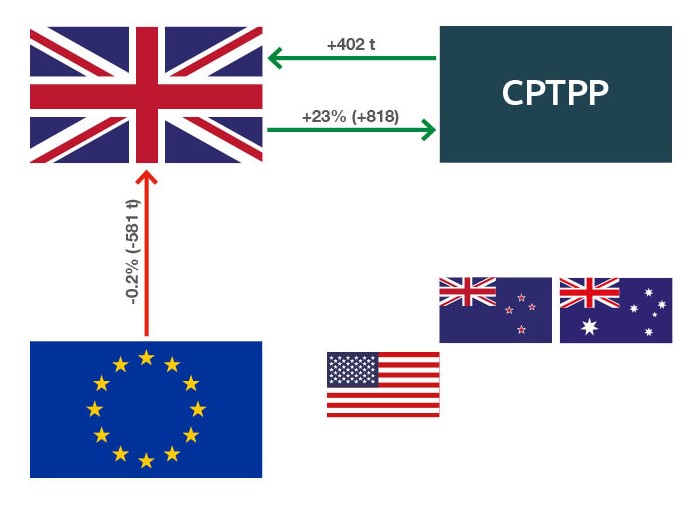- Home
- Pork: modelling the impact of the UK’s accession to CPTPP
Pork: modelling the impact of the UK’s accession to CPTPP
The impact of the UK accession to CPTPP was examined for pork, looking at the changes expected after the deal comes into force. This aspect of the modelling work assumes all other factors, except succession, remain the same.
Key points for the pork sector were:
- The model suggests that CPTPP pork exports to the UK will increase by about 402 t (an increase of 211% in percentage terms on the baseline used within the model)
- The model suggests that UK pork exports to CPTPP will increase by about 818 t (an increase of 23% in percentage terms on the baseline used within the model)
- The model predicts that changes to production and price will be relatively small (less than 1%)
For pork, the chosen network consists of the UK, EU, USA, New Zealand and Australia, and the rest of CPTPP. The EU is a significant exporter of pork, as is the USA. The UK is a net importer, but does export some pork products to New Zealand, the EU and China. Australia and New Zealand are net importers of pork. In the rest of the CPTPP countries, Canada is a major producer and exporter of pork, the third largest after the USA and the EU. Chile also exports a large amount, with the key markets being China, South Korea and Japan, and Mexico, which exports mainly to Japan, China and the USA. There is also a huge amount of pork imported into the CPTPP countries, mainly to Canada, Chile, Japan, Mexico, Singapore and Vietnam. A key consideration when interpreting the results is that the model cannot determine which of the nine countries within the rest of CPTPP node will be importing or exporting the pork.
Figure 1 shows the changes in trade within the network. The model shows an increase of exports from the UK to CPTPP of about 23% (818 t) from the current 3,500 t per year.
The model predicts that UK imports from CPTPP will increase by 402 t from a current level of 190 t. It is worth noting that the UK has negotiated an inward pork TRQ for all CPTPP countries. The TRQ will start at 10 Kt, increasing in equal increments to 55 Kt by year 10 of the agreement. Considering there are some big pork exporters in CPTPP, this will help to protect UK producers from pork flooding the markets.
Analysis by AHDB identified good export potential for pork to Mexico, Canada, Chile and Vietnam, with Singapore and Japan having the best prospects.
Figure 1. Modelling results impacts to pork trade

Note: No connecting arrows indicates minimal change in trade levels.
Domestic marketplace changes are relatively minor, with falls of less than 1% to domestic production, farmgate price and pork sold on the domestic market. There will be a slight increase in retail price in the UK. The impact on the CPTPP countries will be less than 0.01%.
Table 1. Detailed pork results
|
| UK | The rest of CPTPP |
|---|---|---|
|
Domestic production |
-0.6% (-5,201 Kt) |
<0.01% (+ 198 t) |
|
Price paid to producers |
-0.73% |
No change |
|
Total pork sold in the domestic market (incl imports) |
-0.1% (-1.094 t) |
<0.01% (+ 814 t) |
|
Retail price |
+ 0.09% |
-0.01% |
Considerations
The modelling analysis is based on full liberalisation, but as previously discussed, the UK has negotiated a TRQ for pork. Therefore, the CPTPP countries will only be able to import a specific amount of pork tariff-free. The TRQ will start at 10 Kt and increase in equal increments to 55 Kt by year 10 of the agreement. The modelling predicts that CPTPP exports to the UK will increase by 402 t, which would be a fraction of the TRQ.
There are a number of caveats to these results. Like other economic models, the trade network model is not a prediction or forecast and assumes all factors other than UK accession to CPTPP remain equal. This is unrealistic in a global economy but is an essential assumption for modelling due to the complexity of predicting future changes. What the network model can do, though, is examine specific ‘what if’ scenarios, and this is something that AHDB will be analysing going forward.
Like other economic models, the trade network model treats all products in a category as homogenous. In reality, we know that there are varying levels of demand for different cuts of pork in each market. The model treats all cuts as the same, and therefore the impact of carcase balance must be considered alongside the results. As such, our interpretation considers the modelling results within the context of the other analysis and findings.
The model does not take into account Sanitary and Phytosanitary (SPS) limitations such as Export Health Certificates (EHCs) and other trade barriers, such as the ban on hormone-treated beef entering the UK.
Read more about trade implications of Non-Tariff Measures (NTMs)

